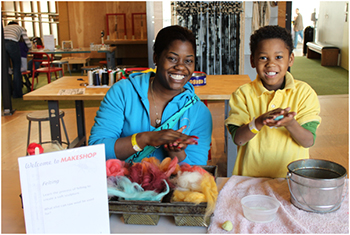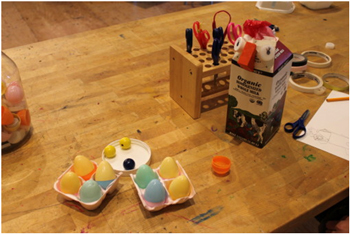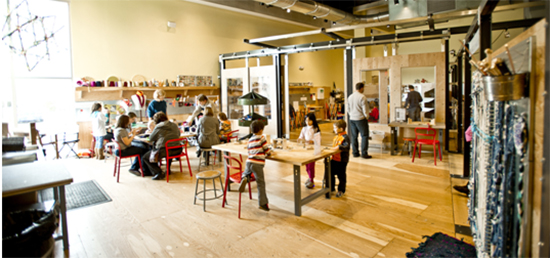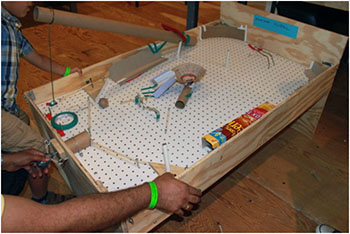The Harvard Family Research Project separated from the Harvard Graduate School of Education to become the Global Family Research Project as of January 1, 2017. It is no longer affiliated with Harvard University.
Spring 2015
Make Your Own Maker Space
 This mother-and-son team were excited to try woodworking. |
|
|

|
 A parent and child team challenged themselves to make a “robotic egg-laying chicken.”
|
At MAKESHOP, a permanent, hands-on exhibit at the Children’s Museum of Pittsburgh, everybody can be a maker. MAKESHOP is a space for tinkering, or for trying out ideas in an exploratory way, using materials the museum provides. Here, adult visitors learn, children learn, and parents witness the feats that their children, with and without their support, can accomplish.
Museum staff members encourage parents to participate in making with and alongside their children. With so many available tools and materials, project options in the space are limitless: a family might collaborate to create a working pinball machine out of recycled materials, or to produce their own stop-motion animation video. Engaging in these new activities, families learn with and from each other. The staff members hope that visiting MAKESHOP will motivate families to engage in additional co-learning after their visit, whether back at MAKESHOP or beyond.
FOUR TIPS
Lisa Brahms, director of learning and research at the museum and project lead for MAKESHOP, shared four tips for creating engaging maker spaces for children and families.
1. Recruit talented, passionate makers
Each of the educators in the space brings “expertise in a different domain of making, such as textiles, electronics, construction, digital media production, and computer programming.” Such specific expertise is beneficial when educators are working with visitors and when shared among the staff.
2. Customize visitor experiences for each child and family
“We use a variety of strategies, such as discussion, observation, or leading by example, to engage each family group in the best way that we’re able,” said Brahms. With a focus on the open-ended process of making, rather than on any particular final product, the team members support visitors by both demonstrating how to use unfamiliar tools and technologies, and figuring out each family group’s interests and intentions in the space. Through observation and dialogue, the educators discern what each family group want to make, or what new skills they want to learn, along with their experience level, and how to bridge any gaps in order to bring their desired project or learning experience to life.
3. Learn from your visitors
Constantly reflecting on their practice and facilitation techniques, MAKESHOP educators seek to fully understand making as a learning process for families. Brahms shared, “This messy and rich design process has offered concrete examples for our practices, surfaced counter-examples, and generated new categories that help shape the core of what we consider ambitious making experiences.” She and her staff encourage visitors, old and young, to collaborate, to learn new skills, and to generate new ideas by playing with “real stuff,” such as felt, wood, and LED lights.
4. Network and share resources
Finally, to help families and educators take what they learn from MAKESHOP to apply these ideas elsewhere, the team members have formed a regional network of formal and informal educators interested in featuring making in a variety of learning settings. In addition, the team are developing a rich resource center for their website. Brahms says that this will be a site for inspiration, supply sources, and recommendations, and will feature relevant research findings and tools to support best practices among educators and families. MAKESHOP is also collaborating with the Institute of Museum and Library Services (IMLS) to develop a framework to support the design of museum- and library-based maker spaces for learning.
MAKESHOP has accomplished an incredible amount in its first three years, so we’re excited to to see how it continues to engage Pittsburgh families in the future.
ADDITIONAL RESOURCES
Check out this video to see the visitor-made pinball machine in action.
Follow the MAKESHOP blog to stay up to date on what visitors and staff are making.
To see the range of activities that go on in the space, watch "A Week in the MAKESHOP Workshop.”
SNAPSHOTS CONTRIBUTOR
Babe Liberman, an Ed.M. candidate at the Harvard Graduate School of Education, is a graduate research assistant at Harvard Family Research Project, focusing on afterschool and expanded learning opportunities. She is an experienced museum educator who enjoys working with youth and family audiences.
|
SEND US YOUR SNAPSHOT! If you’re doing something that you think others should know about, we invite you to send us a description with a photo or short video to fine@gse.harvard.edu with the subject line: SNAPSHOTS. |



